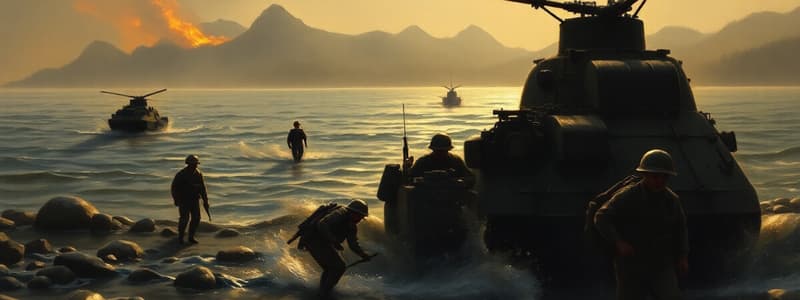Podcast
Questions and Answers
What was the primary objective of the amphibious landing at Inchon?
What was the primary objective of the amphibious landing at Inchon?
- To open a second front in the Korean War
- To conduct a naval blockade against North Korea
- To force the NKPA to retreat from South Korea (correct)
- To establish a permanent military base in South Korea
Who were the primary commanders leading the naval forces during the Inchon invasion?
Who were the primary commanders leading the naval forces during the Inchon invasion?
- Admirals Nimitz and Halsey
- General George S. Patton and General Omar Bradley
- Admirals Struble and James H. Doyle (correct)
- General Douglas MacArthur and General William Westmoreland
What type of military assets were used in the assault against Inchon?
What type of military assets were used in the assault against Inchon?
- Carrier-based aircraft, destroyers, and cruisers (correct)
- Only ground troops from the Army
- Only air support from the Air Force
- Submarines and special forces teams
When did the Marines successfully assault the beaches at Inchon?
When did the Marines successfully assault the beaches at Inchon?
What significant location did the Marines capture shortly after landing at Inchon?
What significant location did the Marines capture shortly after landing at Inchon?
Flashcards
What was the importance of the Inchon landing?
What was the importance of the Inchon landing?
The amphibious landing at Inchon, also known as Operation Chromite, was a key turning point in the Korean War. It involved a surprise attack by UN forces, led by the United States, on the North Korean People's Army (NKPA) at Inchon.
What was the main goal of the Inchon landing?
What was the main goal of the Inchon landing?
The Inchon landing was a strategic military operation aimed at forcing the NKPA to retreat from South Korea. This move ultimately halted the NKPA's advance and pushed them back towards the north.
How did the Inchon landing highlight the role of naval forces?
How did the Inchon landing highlight the role of naval forces?
The Inchon landing demonstrated the crucial role naval forces can play in amphibious operations. The use of ships, aircraft, and marines allowed the UN forces to effectively seize the Korean port city.
Describe the initial stage of the Inchon landing.
Describe the initial stage of the Inchon landing.
Signup and view all the flashcards
How did the 1st Marine Division contribute to the success of the Inchon landing?
How did the 1st Marine Division contribute to the success of the Inchon landing?
Signup and view all the flashcards
Study Notes
Inchon Landing (Operation Chromite)
- The UN force launched Operation Chromite, an amphibious assault at Inchon to force the North Korean People's Army (NKPA) retreat from South Korea.
- The NKPA invaded South Korea on June 25, 1950, initiating the Cold War's first major armed conflict.
- The Inchon invasion highlighted the crucial role of naval forces in coastal warfare.
- On September 13, 1950, naval forces (JTF 7) led by Admirals Struble and Doyle commenced the attack.
- Carrier-based aircraft, destroyers, and cruisers targeted North Korean fortifications, artillery, and supply lines for two days.
- On September 15, 1950, the 1st Marine Division stormed three beaches at Inchon and swiftly captured the city.
- By September 19, 1950, Marines seized Kimpo airbase, facilitating close air support and supply delivery.
- US Army troops advancing from the beachhead connected with their colleagues advancing from the Pusan Perimeter.
- Combined forces (Marines, Army, and South Korean troops) captured Seoul on September 28, 1950.
Studying That Suits You
Use AI to generate personalized quizzes and flashcards to suit your learning preferences.




